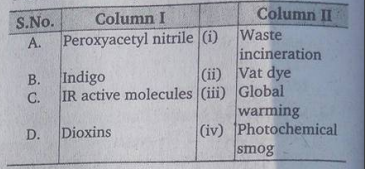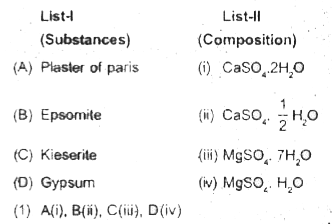Match column-i with column-ii using the code given below.
[{column-i (substance) (a) dead bumt plaster, (b) gypsum, (c) slaked time, (d) plaster of paris}
{column-ii (formula) (i) 2CaSO4,H2O, (ii) Ca(OH)2, (iii) CaSO4,2H2O, (iv) CaSO4
(a)(iv), (b)(i), (c)(ii), (d)(iii)
(a)(i),(b)(iii),(c)(iv),(d)(ii)
(a)(iii),(b)(ii),(c)(iv),(d)(i)
(a)(iv),(b)(iii),(c)(ii),(d)(i)
To solve the problem of matching substances in Column I with their corresponding formulas in Column II, we will analyze each substance and identify its chemical formula step by step.
1. Identify Dead Burnt Plaster:
- Dead burnt plaster is commonly known as anhydrous calcium sulfate.
- Its chemical formula is CaSO4.
- Match: (a) Dead burnt plaster → (iv) CaSO4
2. Identify Gypsum:
- Gypsum is a mineral composed of calcium sulfate dihydrate.
- Its chemical formula is CaSO4⋅2H2O.
- Match: (b) Gypsum → (iii) CaSO4⋅2H2O
3. Identify Slaked Lime:
- Slaked lime is also known as calcium hydroxide.
- Its chemical formula is Ca(OH)2.
- Match: (c) Slaked lime → (ii) Ca(OH)2
4. Identify Plaster of Paris:
- Plaster of Paris is calcium sulfate hemihydrate.
- Its chemical formula is CaSO4⋅12H2O or simply CaSO4⋅0.5H2O.
- Match: (d) Plaster of Paris → (i) CaSO4⋅12H2O
Final Matches:
- (a) Dead burnt plaster → (iv) CaSO4
- (b) Gypsum → (iii) CaSO4⋅2H2O
- (c) Slaked lime → (ii) Ca(OH)2
- (d) Plaster of Paris → (i) CaSO4⋅12H2O
Summary of Matches:
- a → iv
- b → iii
- c → ii
- d → i
- Dead burnt plaster is commonly known as anhydrous calcium sulfate.
- Its chemical formula is CaSO4.
- Match: (a) Dead burnt plaster → (iv) CaSO4
- Gypsum is a mineral composed of calcium sulfate dihydrate.
- Its chemical formula is CaSO4⋅2H2O.
- Match: (b) Gypsum → (iii) CaSO4⋅2H2O
- Slaked lime is also known as calcium hydroxide.
- Its chemical formula is Ca(OH)2.
- Match: (c) Slaked lime → (ii) Ca(OH)2
- Plaster of Paris is calcium sulfate hemihydrate.
- Its chemical formula is CaSO4⋅12H2O or simply CaSO4⋅0.5H2O.
- Match: (d) Plaster of Paris → (i) CaSO4⋅12H2O
- (a) Dead burnt plaster → (iv) CaSO4
- (b) Gypsum → (iii) CaSO4⋅2H2O
- (c) Slaked lime → (ii) Ca(OH)2
- (d) Plaster of Paris → (i) CaSO4⋅12H2O
- a → iv
- b → iii
- c → ii
- d → i
Similar Questions
Knowledge Check
Match the Column I and Column II and choose the correct code given below.
 A(iv)(ii)(iii)(i)B(i)(ii)(iv)(iii)C(ii)(i)(iv)(iii)D(iv)(i)(iii)(ii)
A(iv)(ii)(iii)(i)B(i)(ii)(iv)(iii)C(ii)(i)(iv)(iii)D(iv)(i)(iii)(ii)Match the Column I and Column II and choose the correct code given below.
 A(iv)(ii)(iii)(i)B(i)(ii)(iv)(iii)C(ii)(i)(iv)(iii)D(iv)(i)(iii)(ii)
A(iv)(ii)(iii)(i)B(i)(ii)(iv)(iii)C(ii)(i)(iv)(iii)D(iv)(i)(iii)(ii)Match Column - I with Column-II and select the correct option from the codes given below.
Column-I (A)Fast muscle fibres (B)Slow muscle fibres (C)Actin (D)Sarcomere
Column-II (i)Myoglobin (ii)Lactic acid (iii)Contractile unit (iv)I-bandAA-(i),B-(ii),C-(iv),D-(iii)BA-(ii),B-(i),C-(iii),D-(iv)CA-(ii),B-(i),C-(iv),D-(iii)DA-(iii),B-(ii),C-(iv),D-(i)
Match the important chemical given in column (A) with the chemical formulae given in Column (B).
Column (A) Column (B)(a) Plaster of Paris (i)Ca(OH)2(b) Gypsum (ii)CaSO4.12H2O(c) Bleaching powder (iii)CaSO4.2H2O(d) Slaked lime (iv)CaOCl2
View SolutionThe chemical formula of plaster of paris is CaSO4.2H2O
View SolutionWhich of the following has highest solubility in each of the following :
(i) BaSO4,MgSO4,CaSO4 (ii) Mg(OH)2,Ba(OH)2,Ca(OH)2
View SolutionMatch list-l with list-ii for the composition of substances and select the correct answer using the code given below the lists

View SolutionFormula of gypsum is CaSO4.xH2 and of plaster of parts is (2CaSO4).yH2O, then (x- y) is equal to
View Solution
